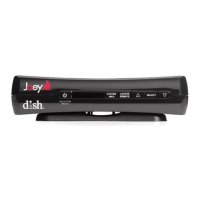1
Joey
The Joey delivers the next-generation of TV content, including
multimedia services over IP-based networks, with high-denition (HD)
and standard-denition (SD) programming. It uses coaxial connections
within the dwelling to connect to the host receiver, a Hopper, and
delivers HD programming and recorded programs from that receiver
through to the Joey. Content includes live, paid, and DVR programming
in HD, SD, and 3D. It uses one of the three available tuners in the
Hopper, or it can display prerecorded content from the DVR or IP-
delivered content.
A single Hopper supports up to three Joeys through the coaxial
connections, or two Hoppers support up to four Joeys. A Joey must
never be directly connected to a Hopper; it must use a Node, a Tap, or
an Isolator for connection to a Hopper.
The remote uses radio frequency (RF) signal to control the Joey and
IR signals to control any other equipment you have programmed. RF
signals travel relatively long distances and can go through walls and
other solid objects. IR signals, used in TV, DVD, and AUX device modes,
travel up to 40 feet in a straight line-of-sight and cannot go through walls
or other solid objects. Point the remote directly at the equipment you
want to control without any objects blocking the signal path.

